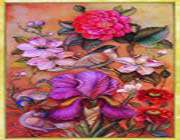Flower and Bird Painting: Genuine Iranian Art (Part 2)

Working flower and bird imprints on artworks has grown in the course of history of Iran since several millennia ago. Flower and bird design with the passage of time gained an exclusive status as a genuine Islamic-Iranian art. Although Simorgh (Phoenix) is a well known legendary symbolic bird, the symbolic status of birds is not confined to Simurgh alone.
Attar in his Mantiq al-Tayr (Language of the Birds) properly explains the diversified characters and dispositions which every single bird represents as a symbol. The metamorphosis in symbolic concept of Simurgh in Islamic culture and its transformation from mythical motifs to the realm of archetypes in Suhrawardi philosophy (1155-1191) find their clearest, most intensive and most eloquent way of expression. Suhrawardi tried to review pre-Islam Iranian cultural paradigms in the light of Islamic cultural concepts. In his systematic review, according to the paradigms of the School of Intuition, Suhrawardi deduces interpretively that Shahnama stories, fully enriched with signs of wisdom of ancient Iranians, aggrandize status of Simurgh to a point that is manifestation of the Lord.
The first representation of the bird in book illustration dates back to a period in ancient Iranian-Islamic traditional art that is called the School of Baghdad. (1)
Today, the contemporary artists in their artistic creations mix real pictures of birds with imagination to illuminate valuable works, outstanding examples of which can be found in the illuminations of the copies of Holy Quran and other books.
Translated by: Sadroddin Musawi
Notes:
School of Baghdad refers to a type of primitive painting that, to some extent, shows lack of skill and artistic capacity of its founders. It is chiefly rich in having religious stories and traditions. The artists of the School of Baghdad were mainly Iranian, creating works of art and illuminated calligraphy books with their own style on the recommendation or order of the tribal chieftains. Their style spread across the Iranian cities and continued through the period of Seljuk Dynasty, when Iranian painting grew substantially.
Other links:
History of the utilization of White Bronze in Iranian Metalwork
Mat-weaving in Iran
Materials and Tools for Mat-weaving in Iran